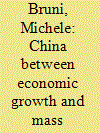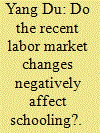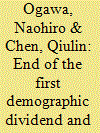| Srl | Item |
| 1 |
ID:
119158


|
|
|
|
|
| Publication |
2013.
|
| Summary/Abstract |
In order to continue along its path of sustained economic growth, China will need, probably in just a few years, certainly after 2030, an extremely high number of immigrants. This conclusion, which contrasts with a recent World Bank scenario suggesting that the decline in labor supply due to demographic trends can be faced with sustained growth in productivity, is based upon a demand-driven model of migration. Moreover, according to the same model, the decline in fertility (and the one child policy that has been partially responsible for it) will end up provoking immigration flows above replacement level. The working age population and the total population will continue to increase, and China will remain the most populous country on the planet. The last part of the paper surveys the policies that China could adopt to reduce its structural need for foreign labor.
|
|
|
|
|
|
|
|
|
|
|
|
|
|
|
|
| 2 |
ID:
119160


|
|
|
|
|
| Publication |
2013.
|
| Summary/Abstract |
The demographic dividend, that is, the growth of the working age population aged 16 years relative to younger and older age dependents, has often been cited as a crucial component of the accelerated economic growth experienced by disparate countries and regions at different points in time. Generally less emphasized are the ramifications of this process when it occurs in reverse; that is, when the relative size of the working age population begins to shrink. Related to this is the more subtle effect of changes to the age structure of the overall working age population, which can have compounding or offsetting effects in relation to the demographic dividend noted above. This paper explores how these age-related phenomena were instrumental to both the Great Depression and the Great Recession of 2008. We explore how the generational composition of economic actors and the aging of the baby-boom worker may have played a role in provoking these remarkable recessionary periods. The reversal of the demographic dividend and the aging of the working age population are factors now contributing to the propagation of the global economic downturn, as witnessed in the example of Japan over the past half-century. This paper applies the lessons of the Great Depression to offer a forward-looking analysis of the Chinese economy. China is on the precipice of a significant demographic shift whose implications for economic growth are explored.
|
|
|
|
|
|
|
|
|
|
|
|
|
|
|
|
| 3 |
ID:
119157


|
|
|
|
|
| Publication |
2013.
|
| Summary/Abstract |
The Chinese labor market has transitioned from a dual labor market to a neoclassical labor market. With wages increasing for skilled workers, the impact on schooling must be considered by policy-makers. Taking advantage of national representative data for 2005 and 2010, the present paper examines the hypothesis that increasing opportunity costs reduce children's schooling. The empirical result is of particular relevance to poor areas, where people tend to have high discount rates and place more value on real time income. Although the total public investment in education has been increasing, our findings suggest that targeting relevant regions and compensating opportunity costs will improve the efficiency of education investments.
|
|
|
|
|
|
|
|
|
|
|
|
|
|
|
|
| 4 |
ID:
119159


|
|
|
|
|
| Publication |
2013.
|
| Summary/Abstract |
This paper sheds light on the nexus of age compositional shifts and the generation of the first demographic dividend over the past several decades in China, and also discusses how this dividend could be extended We first estimate how long China's first demographic dividend will last and then compare the computed results for China with those for other selected Asian countries in order to place the Chinese case in a wider perspective. Furthermore, in view of the possibility that China's first demographic dividend will turn negative in 2014, we offer insight into how and to what extent China's labor market needs to adjust and how much labor income must increase for the first demographic dividend to remain positive up to year 2050. For this goal to be achieved, the labor income age profile needs to be shifted to a considerable extent. We conduct an exercise in which the 2007 peak labor income age of 32 years is shifted to 40 years. In the case of the elderly, this implies an annual labor income growth of 3.1 percent over the period of 39 years. Throughout this paper, we draw on a variety of computed results derived from the Chinese component of the global "National Transfer Accounts" project.
|
|
|
|
|
|
|
|
|
|
|
|
|
|
|
|
| 5 |
ID:
119156


|
|
|
|
|
| Publication |
2013.
|
| Summary/Abstract |
This paper investigates trends in intergenerational patterns of educational attainment of those born in China between 1941 and 1990. Employing the 2008 Rural-Urban Migration in China and Indonesia Survey, we find that intergenerational correlation is lower in rural and migrant than in urban populations. The higher mobility observed in rural and migrant populations stems from the fact that the majority of these children complete only junior high school, with some children in the youngest cohorts moving down the education ladder relative to their parents. In contrast, urban children seem to at least maintain their parents' education level. The persistence of intergenerational transmission of education at high levels in urban areas combined with some mobility, upward or downward, in rural areas is likely to aggravate China's rural-urban disparity. Policies should focus more on the underlying gaps in education opportunities and the improvement in education of the rural and migrant populations.
|
|
|
|
|
|
|
|
|
|
|
|
|
|
|
|
| 6 |
ID:
119155


|
|
|
|
|
| Publication |
2013.
|
| Summary/Abstract |
As a result of the shrinking working age population (aged 15 to 59 years), all factors that have driven China's rapid economic growth over the past 30 years tend to diminish from 2010. The present paper estimates the average annual growth rate of potential output to be 7.2 percent over the 12th Five-year Plan period and 6.1 percent over the 13th Five-year Plan period. Future sustainable growth requires furthering economic reform in related areas to enhance potential growth. This paper simulates two scenarios in which both an increase in labor force participation and improvement in total factor productivity can significantly enhance the potential GDP growth rate. Relevant policy implications are discussed.
|
|
|
|
|
|
|
|
|
|
|
|
|
|
|
|